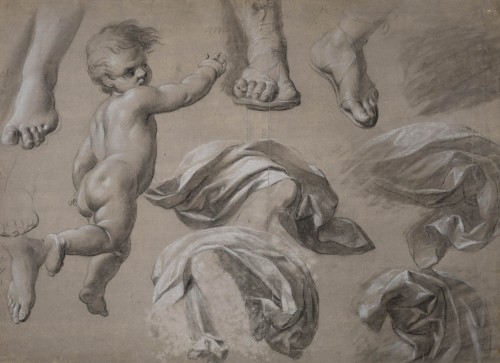Spanish Old Master Drawings
Study of drapery, child’s figure and feet
Zacarías González Velázquez
(Madrid, 1763-1834)
- Date: c. 1792
- Pencil and black chalk, with white chalk highlights, on grey-tinted paper
- 378 x 525 mm
In the mid-17th century a small oratory was built in central Madrid to the design of Juan de Torija, Chief Surveyor of Royal Works, and dedicated to Jacobo Gratij, a Knight of the Order of Christ and Papal Nuncio to Gregory XIII at the court of Philip II. Gratij had settled in Madrid, taken the vows of priesthood and used his own fortune to found the Royal, Ancient and Venerable Congregation of Lowly Slaves of the Holy Sacrament, which devoted its activities to promoting the cult of the Eucharist. By the following century the oratory, known as the Real Oratorio del Caballero de Gracia, was too small to meet the Congregation’s requirements and in 1782, during the reign of Charles III, work began on its rebuilding. The new design was by Juan de Villanueva, Chief Architect of Royal Works, and was as such that architect’s first religious commission. For the tempera paintings on the dome Villanueva recommended Zacarías González Velázquez, considered the best-known court artist of the time. González Velázquez had initially trained with his brother-in-law Mariano Salvador Maella then enrolled as a student at the Academia de Bellas Artes de San Fernando in Madrid in 1777 where his father, the painter Antonio González Velázquez, was director. After his apprenticeship he became an academician in 1790 and would eventually be director of the Academia from 1828 to 1831. Among the commissions which Zacarías González Velázquez received from the court were the frescoes for a number of the Royal Residences, including El Pardo and the Casa del Labrador in Aranjuez. He combined this activity with the production of religious works commissioned from all over Spain: working alongside Goya in the Santa Cueva in Cadiz; producing works for Toledo cathedral, the cloister of the church of San Francisco el Grande in Madrid, and the parish church of Jaén cathedral; and painting canvases and murals for the Oratorio del Caballero de Gracia in Madrid, the project with which the present four canvases are associated. González Velázquez received instructions directly from the Congregation regarding the subjects to be painted on the hemispherical dome, lantern and pendentives, as the documentation records. For the decoration of the triangular spaces of the four pendentives he was instructed to paint “Saint Michael, Saint Gabriel, Saint Raphael and the Holy Guardian Angel.” The four frescoes depict the flying figures of the three Archangels and the Guardian Angel within ovals. All have their characteristic attributes which allow them to be identified: Michael is trampling on a serpent symbolising Evil; Gabriel is holding some lilies and points to the Dove of the Holy Spirit, both emblems of the Annunciation; Raphael has a fish; and the Guardian Angel is protecting a child in its arms. The colouring, elegance and movement of the figures make this drawing among the finest works by Zacarías González Velázquez, as well as outstanding examples of Spanish Neo-classical painting. This drawing is also particularly important given that the tempera paintings for the pendentives in the Oratorio have not survived. They were seriously damaged by damp (and during the restoration undertaken from 1975 to 1979 the wall surface on which they were painted was chipped off, resulting in their permanent loss.


